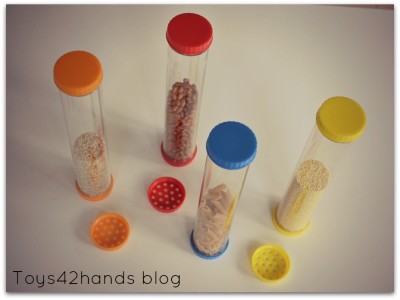Experiment with looking at moving objects, listening and smelling
Author: Els Rengenhart
Occupational therapist and SI specialist
Sensory Tubes consists of four transparent tubes, eight closed screw caps to close the tubes and four screw caps with holes in them to let air through. The tubes can be filled with different materials. 
To look
The tubes are transparent and can be placed upright. By filling them with different materials such as chestnuts, acorns, dried leaves, rice, beans, macaroni, small toys and confetti, they look different every time. The tightly sealable caps make it possible to fill them with water or another liquid, for example with a little soap suds, glitter, plastic figures, etc. In this way, children can experiment with what they like to look at. In this way, the tubes can be a nice decoration for a child's room. The big advantage is that there is endless variation. In this way, you will not get tired of it quickly.

Looking at and experiencing movements
The tubes also invite further experimentation. Especially when they are filled with materials such as colored sand, rice, beans, water with glitter and so on. I filled the tubes about halfway with rice, beans, dry pasta and millet. They then strongly entice you to grab and move with or between two hands. For example, the rice then rolls from one side of the tube to the other. In addition to seeing the rice move, you also clearly feel the weight of the rice being transferred from one hand to the other, and you hear the sound that the rice is making when it moves. By moving slower or faster, it looks slightly different, and the sound and feeling in your hands are also different. Rolling or shaking the tubes also gives you a different experience of what you see, hear and feel.
To belong
By moving the tubes, which are partly filled with sand, rice, beans, pasta and the like, you turn the tubes into a 'musical instrument'. You can produce different sounds by filling the tubes more or less, moving them more or less quickly and varying the movements. You can also play different sound games with it. For example, by filling the four tubes with four different materials, and then making a sound with one of the tubes, without your child seeing it. The child then has to guess which tube made the sound.

Smell
The tubes also come with four lids, which have holes to let air through. These are especially suitable for experiencing different scents. The tubes can be filled with strongly scented herbs or a potpourri (mixture of fragrant herbs and flowers). Be careful that the herbs or flower mixture cannot fall through the holes when the tubes are moved. You can also put a drop of perfume, essential oil or any other strongly scented liquid on a cotton ball, tissue or piece of cloth and put it in the tubes. Another idea is to buy small cuddly toys that fit in the tubes and put a drop of perfume or aroma oil on them. You can then use four different cuddly toys, but if you buy four of the same cuddly toys, the child can also try to recognize the different scents. Here too, there are plenty of difficulties. Do not use too many scents together because that can sometimes cause confusion.
I think the Sensory Tubes are suitable for children from 3 years old. They provoke more exploration than I initially thought. By getting started with them, the possibilities keep piling up. The various sensory stimuli ensure that the child focuses its attention, and especially moving the tubes yourself ensures that the child retains that attention and starts experimenting with the tubes. Due to the many possibilities, Sensory Tubes are also suitable for children and even adults with a physical or mental disability.




























Leave a comment